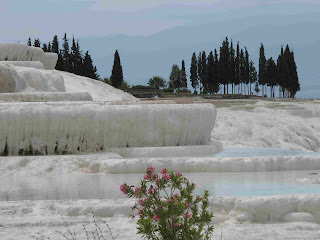The next morning we headed off to explore the travertine terraces. Without question, I can say that this was the coolest “water park” I have ever been to, and it’s all natural too! The travertines were formed when warm mineral water cooled and deposited calcium as it cascaded over cliff edges. In an effort to help preserve this amazing site, only certain areas of the travertines are open, and you must take off your shoes before you begin walking on the terraces.
The travertine terraces of Pamukkale
Stani in one of the travertine pools
Kirstin and Stani in Pamukkale
Behind the travertines are the ruins of the ancient Roman spa city of Hierapolis. It was a place where people came for a miracle cure. A theatre, agora, communal latrines, a church, a Temple of Apollo and a huge necropolis (cemetery) are all still visible. The center of Hierapolis was probably the sacred pool which is now a swimming pool where you can bathe in warm water surrounded by submerged sections of ancient marble columns and statues. For various reasons, including price and hygiene, we decided not to take a dip.
The ancient spa city of Hierapolis
The next morning we continued eastward towards Konya, home of the whirling dervishes and the Mevlana Museum. On the way, we saw a Toyota dealership and decided to stop to get an oil change. Luckily there was a young guy who spoke some English, and Stani was able to communicate what we needed. Before we drove off, one of the workers presented me with a rose. I couldn’t believe it! Occasionally I would get a rose from the service manager, Mac at the Saab dealership in Ann Arbor, if they were having a special customer appreciation day, but this was such a nice surprise to get one in Turkey.
As we got closer to Konya, rain was falling steadily. Once inside the city, it was clear this was not just a passing shower. To add to the challenge, the only map we had of this city of 762,000 people was a small one in our Lonely Planet guidebook. There were signs pointing to the city’s main attraction, the Mevlana Museum, so I kept following those. Our guidebook listed a hotel near the museum which seemed like a good candidate, now we just had to find it. The further we got into the city, the heavier the storm showers fell. I had experienced monsoons when I was in India in the summer of 1999, and this rain felt very much like a monsoon. In India I was on foot, now I was driving. I’m not sure which was worse! By the time we got to the center of the city it was full blown rush hour. Cars, trucks, motorbikes, bicycles, people pushing carts piled high with vegetables, and people on foot hurrying home from work. It was chaos, and here I was trying to just get through it all. We finally found our hotel and by this time it had stopped raining, but the next challenge was to figure out how to get our car to the hotel. We spent about an hour hour driving around before we finally were able to find the hotel again and the nice man who worked there came to our car and guided us to the hotel. Exhausting!!! I think I ate a piece of bread and went to sleep.
On the streets in Konya after the rain
The next morning we walked to the Mevlana Museum, a former lodge of the whirling dervishes. The whirling dervishes are an order of Sufi Islam who are followers of Celaleddin Rumi. Rumi was a great philosopher, poet and mystic who lived from 1207-1273. Later in his life, he became known as Mevlana which means “our guide”. Tolerance is central to Mevlana’s teachings.
The Mevlana Museum
The whirling dervishes’ worship ceremony is a ritual dance representing union with God. The dervishes wear a long white robe with a full skirt covered with a black cloak and a conical felt hat. The white robe symbolizes their shrouds, the black their worldly tombs and the hats their tombstones. Their ceremony begins with the leader saying a prayer for Mevlana and reciting a verse from the Quran. The dervishes then walk in a circle around the room three times and drop their black cloaks to symbolize their release from worldly attachments. One by one they then spin out onto the floor with their arms folded at their chests. This symbolizes leaving earthly life and being reborn in a mystical union with God. They then move their arms holding their right arm up to receive the blessing of heaven and their left arm down to symbolize the blessings coming to earth. This dance is repeated over and over again. Finally the leader chants passages from the Quran which seals the mystical union with God. Unfortunately we didn’t get to see the ceremony live, only on a video they had on display at the museum. At the museum we also visited the mausoleum with Mevlana’s tomb and several rooms exhibiting Qurans, prayer rugs and other Islamic artifacts.
The Mevlana Museum
A visit to the Turkish barber








No comments:
Post a Comment